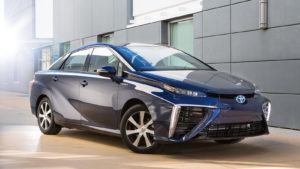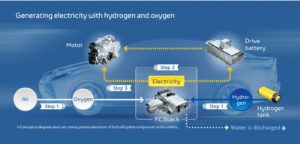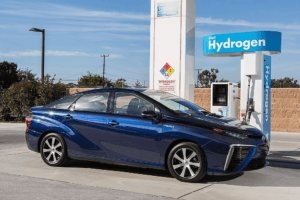Toyota’s new challenge: Fuel cell vehicle “MIRAI”

Toyota tackles hydrogen fueling challenges by introducing fuel cell vehicle “MIRAI”. The company hopes the vehicle will mirror the success of “Prius”.
The Automobile industry and the fuel cell vehicle technology
Automobile industry is currently in a major revolutionary period. As global warming becomes a serious issue, the automobile industry has been engaged in CO2 emission reduction. This movement is expected to accelerate after the US as the largest CO2 emitter and China have ratified Paris Agreement (COP21) [1]. Presently, in addition to gasoline, clean diesel engine, hybrid, and electric vehicles (EV) are now available in the market. EV particularly shows a marked popularization in recent years with Tesla and Nissan as its major manufacturers. Toyota is widely known as the first company to introduce hybrid vehicle “Prius” in the world in 1997. The introduction of the hybrid vehicle system developed a new market; the major car makers all now each have a lineup of ecologically-friendly vehicle. As the next step of evolution, Toyota is currently focusing on fuel cell vehicle (FCV). In December 2014, Toyota introduced the world’s first mass-produced FCV “MIRAI” (which means “Future” in Japanese) as a pioneer to actualize a hydrogen energy based society [2]. With the consideration of high efficiency, cruising distance comparable to gasoline vehicle, short filling time, and only water emission during driving, the vehicle definitely holds very high potential environmental technology as “Ultimate ecologically-friendly vehicle.”

The industry structure can be drastically changed when FCV becomes popular. Thus, Toyota has been daringly striving not for EV but for FCV. However, the popularization requires infrastructure development to supply hydrogen. Especially for Toyota, the U.S. market is extremely important as they are the market leader; without success in the U.S. market, popularization is virtually impossible.

Approach for diffusion of infrastructure development in the US
From 2013, a new partnership called “H2USA” was established by Department of Energy, automobile manufacturers, and Fuel Cell & Hydrogen Energy Association for expanding diffusion of fuel cell vehicle and hydrogen station in some states to a nationwide scale. Besides the US automobile manufacturers, the Japanese and Korean automobile manufacturers such as Toyota, Honda, Nissan, and Hyundai are also participating in H2USA. H2USA is presently planning to build hydrogen stations across the US by 2020. In addition, H2USA is involved with the development plan for hydrogen station in the state of New York, Massachusetts, Connecticut, and Rhode Island [3].
The most advanced state for hydrogen usage in the US is the state of California at present, and California operates one and only hydrogen station in the US while approximately 230 fuel cell vehicles are already running on the roads. The state has introduced the emission regulation including CO2 called “Zero emission vehicle (ZEV) regulation” to automobile manufactures [4]. It is a strict regulation and requires automobile manufacturers to sell ZEV or vehicle without CO2 emission such as EV and FCV in definite proportion of the entire number of vehicles sold in the state. For that reason, many automobile manufacturers are planning to sell EV and FCV in California.
The diffusion of hydrogen stations in the state has been progressed in cooperation with California Fuel Cell Partnership (CaFCP) as a public-private partnership organization, California Energy Commission (CEC), and California Air Resources Board (ARB) [5] [6] [7]. According to “California Road Map” announced by CaFCP in 2012, the state needs 68 hydrogen stations by early 2016 and nearly total 100 hydrogen stations would also be required by 2017-2018 depending on the number of FCVs [8]. Because of the estimations, Governor Brown enacted the state law for usage expansion of clean energy vehicle in September 2013 and also announced the development of maximum 100 hydrogen stations in the state by investing 20 million dollars annually. As of April 2014, 17 hydrogen stations were opened in California and 51 hydrogen stations will be established by 2017.

Possible future plans
Although infrastructure development has been proceeding in some states like California, it is still insufficient at all so far.
If Toyota wishes MIRAI to be successful in future, there would be two possible approaches for the company. Firstly, the company could sufficiently indicate technical advantages to government in each country and actively request to develop hydrogen stations. This would be an ideal solution, however, since government does not always respond promptly, it may take several years which can be a huge risk for this project. Secondly, the company may aggressively develop infrastructure by its own funds. The problem for this is that it requires a significant investment, and there also could be regulatory barriers in some regions. The ratification of COP21 by each country is an advantageous situation, but survival of the technology will certainly depend on further development of FCV technology and an aggressive approach for infrastructure development by Toyota from now on.
(Word counts: 763 words)
References:
[1] United Nations Framework Convention on Climate Change. 2016. Paris Agreement – Status of Ratification. Available at: http://unfccc.int/paris_agreement/items/9444.php.
[2] Toyota Mirai – The Turning Point. Available at: https://ssl.toyota.com/mirai/index.html
[3] Participants | H2USA. Available at: http://h2usa.org/participants
[4] Zero Emission Vehicle (ZEV) Program. 2016. Zero Emission Vehicle (ZEV) Program. Available at: https://www.arb.ca.gov/msprog/zevprog/zevprog.htm.
[5] California Fuel Cell Partnership. Available at: http://cafcp.org/.
[6] California Energy Commission. 2016. California Energy Commission. Available at: http://www.energy.ca.gov/.
[7] California air resources board. 2016. Air Resources Board – Homepage. Available at: https://www.arb.ca.gov/homepage.htm.
[8] California Fuel Cell Partnership. 2012. A California Road Map: The Commercialization of Hydrogen Fuel Cell Vehicles. Available at:



An interesting read!
I think you highlight a key issue in operations planning, which is the role of reliability of future government action: “since government does not always respond promptly, it may take several years which can be a huge risk for this project.”
When it comes to sustainability, it feels like the typical response of a government seems to be consider incentives and regulations i.e. carrots and sticks in the same way they do other issues. I think there is not enough of a push for simply making decisions swifter and expectations more reliable to address the urgency of the probem. The benefit to an organisation’s operations team seems clear: it is easier to choose to invest in a project given certainty, while they may be forced into paralysis due to uncertainty.
I agree with the challenges of building out infrastructure both in terms of governmental latency and capital requirements. BMW, a long partner with Toyota on developing hydrogen technology (and also not-so-climate-change-friendly sports cars), face very similar issues as the US is the 2nd largest market behind EU (and the largest if compared at the country level).
As per Apeksha’s comment, there is a great deal of uncertainty in terms of the pace in which governments will react. However, I believe with Toyota’s strength in EV and hybrid vehicles, they can serve as the industry leader to round up other car manufacturers for support and spearhead the development of hydrogen refueling sites. In addition, while it may sound counter-competitive, it could benefit the industry for Toyota to share some technology with other large manufacturers for hydrogen fuel vehicles. This could expedite the more wide-spread manufacturing of hydrogen fuel vehicles and incentivize both manfuacturers and the government to push for developing infrastructure.
I definitely agree that fuel cell vehicle is ultimately more eco-friendly choice given that most electric vehicles rely on electricity which are generated from fossil energy whereas hydrogen are naturally abundant and the technology to produce/capture it requires much less efforts. But as you pointed out, infrastructure is the key to the success of new alternative vehicle. A single company alone would not be able to account for all the necessary investments in infrastructure, and the more companies choose to go for FCV, the more likely investment in infrastructure will follow. Yet at the same time, increasing competition can jeopardize Toyota’s plan to take over the new market. I wonder how such competitive dynamics influence Toyota’s efforts to collaborate with other automobile manufacturers.
One interesting challenge to the Mirai’s widespread adoption is its current price point. At $57.5K, many consumers are priced out of buying a Mirai [1]. For context, the average new car purchase in 2015 was $33.5K. Given the low distribution of hydrogen stations, I’d be curious to know how Toyota plans to gain market share in spite of the dual challenge of limited refilling stations and a high price point.
[1] https://ssl.toyota.com/mirai/fcv.html
[2] http://www.usatoday.com/story/money/cars/2015/05/04/new-car-transaction-price-3-kbb-kelley-blue-book/26690191/
I’m quite impressed that Toyota, despite their success with the Prius, did not rest on their “green” laurels (pun intended), or make only incremental changes to EVs, but have in fact pushed ahead into a new technology sector! What is interesting to me is how Toyota manages potential internal conflict between the two technology types. Presumably, both EVs and FCVs benefit from economies of scale, both in the manufacturing of the vehicles as well as the infrastructure required to operate each. By splitting their investment, Toyota is both hedging their bets on takeoff of each technology, as well as losing scale benefits. This is both courageous and risky! Or perhaps they see the Prius as first-generation, and FCVs as second-generation? I’d love to see from a company-wide perspective how they manage investments between the two, and how they fit together into the company’s overall strategy.
I agree with Margaret. The main challenge for any new technology is to achieve scale – especially for one that requires so much investment in infrastructure. The only scenario in which Toyota should pursue a strategy around FCVs is if they truly believe that this technology is far superior and will be the ultimate winner. If that is not the case, then they should focus on EVs. But pursuing both avenues will keep them from being a leader in either segment.
Hi Kei, I liked your article. I don’t know too much about fuel cell technology, but it sounds even better than electricity powered cars. I’m actually surprised that the cost for the car is relatively low at $60k. What is the difference in energy/costs required to provide hydrogen fuel vs. electricity? I wonder if Toyota can autonomously build hydrogen re-fueling stations across the nation similar to what Tesla has done for electric charging stations. That way, Toyota wouldn’t need to wait for the government to intervene and build infrastructure. I’d love to learn more about how the hydrogen energy is produced and stored. It would also be interesting to know how hydrogen power compares to that of an electric battery or combustion engine. Would the driving range of the MIRAI be similar to a Prius?
Great article Kei! Fuel cell technology is a very interesting field that has witnessed many advances recently. How do you feel about the manufacturing process of fuel cell batteries? Do you think the technology is there to go mainstream or will typical batteries beat it to market?
Kei, great read. Very thoughtful and engaging! I keep on thinking if any efficiency at the vehicle level is only marginal if we can’t increase utilization. Vehicle utilization hovers at under 10% and the footprint of building these vehicles is huge. I wonder if, as a society, the answer lies in more efficient technology or pursuing the future of driverless. Driverless technology could bring the power of 100% utilization and thus vastly reducing the number of vehicles we need to produce. Perhaps it’s a combination?
Kei, good article but I take exception to a few points that Toyota is trying to claim about their vehicle. Specifically, I am thinking about energy density and production. Obviously when looked at just the vehicle, fuel cells appear to be incredible on surface, especially with extremely low emissions and potentially “renewable” energy. However, transporting, storing, and producing hydrogen require a substantial amount of energy and cost. Unlike gasoline pure hydrogen is not very energy dense and there are fewer bonds to take advantage. On the other side, hydrogen is also difficult to store and transport (it is also highly unsafe). If Toyota could have a different type of fuel cell that can take care of the transport of production aspect, this technology will be amazing.